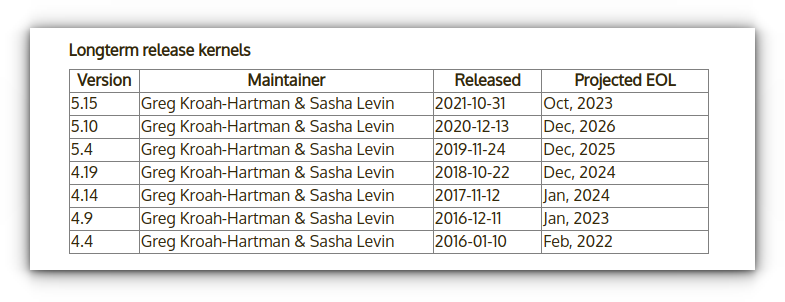- Difference between Mainline, Stable, and Longterm Kernel in Linux
- Mainline Kernel
- Stable Kernel
- Longterm Kernel
- Active kernel releases
- Distribution kernels
- Releases FAQ
- When is the next mainline kernel version going to be released?
- What is the next longterm release going to be?
- Why are some longterm versions supported longer than others?
- Does the major version number (4.x vs 5.x) mean anything?
- Does the odd-even number still mean anything?
- Other resources
- Social
- What is the Release Schedule for Linux Kernel? How Long a Linux Kernel is Supported?
- Linux kernel release schedule: is there any?
- How long a kernel version is supported?
- The LTS Kernel: How long is it supported?
- Your distribution may not follow the usual Linux kernel releases
- No straight forward answers
Difference between Mainline, Stable, and Longterm Kernel in Linux
The Linux kernel (developed by Linus Torvalds) is a basic fundamental component of the operating system. It is responsible for managing all the essential hardware and software components by acting as a bridge between them, hence without it we cannot have Linux-based systems. But do you know Linux kernel also has various releases that signify how well stable it is to use for some crucial projects…
In this article, we’ll discuss what makes the Mainline kernel, Stable kernel, and Long term kernel versions different from each other in Linux.
Mainline Kernel
The Mainline kernel is a freshly released and under-development version of the Linux kernel. It offers up-to-date features and improvements. The release period of the new Mainline kernel is after every 2 or 3 months.
Mainline Linux Kernel as its name suggests, is the stage where most of the new features and improvements are introduced by the developers to the Kernel. But being the first public release, all bugs would not have been fixed, since it was made available. Hence, users who install the Mainline kernel on their systems may find stability and performance issues.
Also, that is the reason why users should avoid using the Mainline branch kernel in their production Linux server operating systems. Nevertheless, you can install the Mainline kernel on your local system to experience its new improvements and additions before getting officially on your Linux OS.
Thus, this kernel should only be used if the feature set it provides is necessary.
Stable Kernel
The Stable kernel refers to versions of the Linux kernel that has undergone vigorous testing and patching. As compared to Mainline, it includes bug fixes, security updates, features from previous versions, and new additions which are deemed stable enough for general use by many users.
Hence, Stable Kernel provides users a safe option of Kernel to install on their production systems and to access some new technology or features before officially becoming available in their favorite Linux distro (like Ubuntu).
So, keep your Linux system up-to-date by installing a Stable kernel. As bug fixes from the mainline kernel tree are backported and periodically made available through it, usually on a weekly basis to ensure the smooth running of the Linux system.
Longterm Kernel
As the name of this Kenrel suggests, it is supported for the Long-Term by backporting the important bug fixes to the older version of the mainline release. Hence, the Long-term supported Kernel includes earlier supported versions of the mainline series but is extremely stable and bug-free, however, from time to time, patches are supplied if some vulnerability is detected by the developers.
The main reason to keep LTS kernels around even long after their initial release dates is to provide support for older hardware or system configurations that work best with certain older versions of software packages or drivers.
But Long term support and rigid stability come at the cost of fewer features as compared to the newer versions of Kernel. Nevertheless, they tend to have longer support timeframes so they can be used on critical servers without having to worry about potential security issues due to an outdated version of programs being run without updates applied.
In conclusion, understanding the differences between these three types of Linux kernel releases can help you make an informed decision when it comes to choosing one for your specific needs in a Linux environment – whether that requires cutting-edge features yet to be released in stable releases or well-tested versions best used in production environments along with support for legacy hardware or technologies later generations lack support for.
Active kernel releases
There are several main categories into which kernel releases may fall:
Prepatch Prepatch or «RC» kernels are mainline kernel pre-releases that are mostly aimed at other kernel developers and Linux enthusiasts. They must be compiled from source and usually contain new features that must be tested before they can be put into a stable release. Prepatch kernels are maintained and released by Linus Torvalds. Mainline Mainline tree is maintained by Linus Torvalds. It’s the tree where all new features are introduced and where all the exciting new development happens. New mainline kernels are released every 9-10 weeks. Stable After each mainline kernel is released, it is considered «stable.» Any bug fixes for a stable kernel are backported from the mainline tree and applied by a designated stable kernel maintainer. There are usually only a few bugfix kernel releases until next mainline kernel becomes available — unless it is designated a «longterm maintenance kernel.» Stable kernel updates are released on as-needed basis, usually once a week. Longterm There are usually several «longterm maintenance» kernel releases provided for the purposes of backporting bugfixes for older kernel trees. Only important bugfixes are applied to such kernels and they don’t usually see very frequent releases, especially for older trees.
Longterm release kernels| Version | Maintainer | Released | Projected EOL |
|---|---|---|---|
| 6.1 | Greg Kroah-Hartman & Sasha Levin | 2022-12-11 | Dec, 2026 |
| 5.15 | Greg Kroah-Hartman & Sasha Levin | 2021-10-31 | Oct, 2026 |
| 5.10 | Greg Kroah-Hartman & Sasha Levin | 2020-12-13 | Dec, 2026 |
| 5.4 | Greg Kroah-Hartman & Sasha Levin | 2019-11-24 | Dec, 2025 |
| 4.19 | Greg Kroah-Hartman & Sasha Levin | 2018-10-22 | Dec, 2024 |
| 4.14 | Greg Kroah-Hartman & Sasha Levin | 2017-11-12 | Jan, 2024 |
Distribution kernels
Many Linux distributions provide their own «longterm maintenance» kernels that may or may not be based on those maintained by kernel developers. These kernel releases are not hosted at kernel.org and kernel developers can provide no support for them.
It is easy to tell if you are running a distribution kernel. Unless you downloaded, compiled and installed your own version of kernel from kernel.org, you are running a distribution kernel. To find out the version of your kernel, run uname -r :
# uname -r 5.6.19-300.fc32.x86_64
If you see anything at all after the dash, you are running a distribution kernel. Please use the support channels offered by your distribution vendor to obtain kernel support.
Releases FAQ
Here are some questions we routinely receive about kernel release versions. See also the main «FAQ» section for some other topics.
When is the next mainline kernel version going to be released?
Linux kernel follows a simple release cadence:
- after each mainline release, there is a 2-week «merge window» period during which new major features are introduced into the kernel
- after the merge window closes, there is a 7-week bugfix and stabilization period with weekly «release candidate» snapshots
- rc7 is usually the last release candidate, though occasionally there may be additional rc8+ releases if that is deemed necessary
So, to find the approximate date of the next mainline kernel release, take the date of the previous mainline release and add 9-10 weeks.
What is the next longterm release going to be?
Longterm kernels are picked based on various factors — major new features, popular commercial distribution needs, device manufacturer demand, maintainer workload and availability, etc. You can roughly estimate when the new longterm version will become available based on how much time has elapsed since the last longterm version was chosen.
Why are some longterm versions supported longer than others?
The «projected EOL» dates are not set in stone. Each new longterm kernel usually starts with only a 2-year projected EOL that can be extended further if there is enough interest from the industry at large to help support it for a longer period of time.
Does the major version number (4.x vs 5.x) mean anything?
No. The major version number is incremented when the number after the dot starts looking «too big.» There is literally no other reason.
Does the odd-even number still mean anything?
A long time ago Linux used a system where odd numbers after the first dot indicated pre-release, development kernels (e.g. 2.1, 2.3, 2.5). This scheme was abandoned after the release of kernel 2.6 and these days pre-release kernels are indicated with «-rc».
Other resources
Social
This site is operated by the Linux Kernel Organization, Inc., a 501(c)3 nonprofit corporation, with support from the following sponsors.
What is the Release Schedule for Linux Kernel? How Long a Linux Kernel is Supported?
Linux kernel is complicated. And I am not even talking about the code.
The code itself is complicated but you do not need to bother with that. I am talking about the release schedule of a Linux kernel.
How often a new kernel version is released in a year? How long a kernel is supported? There are LTS (Long Term Support) kernels. How long the LTS Linux kernels are supported?
The thing is that while these questions may seem simple, the answer is not.
There is no one answer to these questions and it needs some explaining to do and that’s what I am going to do in this article.
Linux kernel release schedule: is there any?
The short answer is that a new kernel version is release every two to three months. The long answer is that it’s not a hard and fast rule.
What it means is that you’ll often see a new kernel version release every two to three months. That’s what the kernel maintainer team targets but there is no set deadline that the new version has to be released exactly 8 weeks from the previous release.
A new kernel version is released (often) by Linus Torvalds when it is ready. This typically happens every 2 to 3 months. The release is declared ‘stable’ and is usually numbered in the format of X.Y.
But this is not the end of X.Y development. The stable release gets further smaller releases to accommodate bug fixes. These small releases add one more point to the stable kernel to make it like X.Y.Z.
While X.Y is (often) released by Linux creator Linus Torvalds, the responsibility to maintain the stable X.Y kernel, merge bug fixes and release X.Y.Z versions is handled by a kernel developer.
How long a kernel version is supported?
Like the release, there is no fixed dates and schedule for how long a kernel version will be supported.
A regular stable kernel release is usually supported for two and a half months to three months, depending on the release of the next stable kernel release.
For example, stable kernel 5.14 would reach end of life a couple of weeks after the release of stable kernel 5.15. The end of support is announced by the maintainer of that particular stable kernel version in the Linux kernel mailing list. Users and contributors are asked to switch to the newly released stable version.
This is applicable to the normal stable kernel versions only. There are LTS (long term support) kernel versions as well and they are supported for a much longer period than just 3 months.
The LTS Kernel: How long is it supported?
There is no set release schedule for LTS kernel as well. Usually, there is one LTS kernel release every year, usually the last release of the year and it is supported for at least two years. But again, there is no set rules here as well.
The maintainer of a LTS kernel may agree to maintain a certain LTS kernel for longer than the usual period of two years. The agreement is done based on the necessity and the players involved.
This often happens for the Android projects. Since two years is not long enough for the manufacturers to bring support for their hardware and software features, you’ll often find some LTS kernels to be supported for six years.
Your distribution may not follow the usual Linux kernel releases
If you check your Linux kernel version, you may find that your distribution uses an old kernel. It could also be possible that the kernel offered by the distribution has reached end of life as per the kernel website.
Don’t panic. Your distribution takes care of patching the kernel for bug fixes and vulnerabilities. Unless you are really using an obscure Linux distribution, you can trust your distro to keep it safe and sound.
You are free to install the latest Linux kernel in Ubuntu or whichever distribution you use if you have good enough reasons such as support for newer hardware.
No straight forward answers
As you can see, there are no straight forwards answers to the Linux kernel release schedule questions. Everything is tentative.
The good thing, in my opinion, is that if you use a regular Linux distribution, you don’t need to bother a lot about the release or end of life of Linux kernel versions. That is something handled by your distribution.
I hope you have a little bit better idea on the Linux kernel release cycle or perhaps I confused you more than ever. In either case, let me know your views in the comment section.



